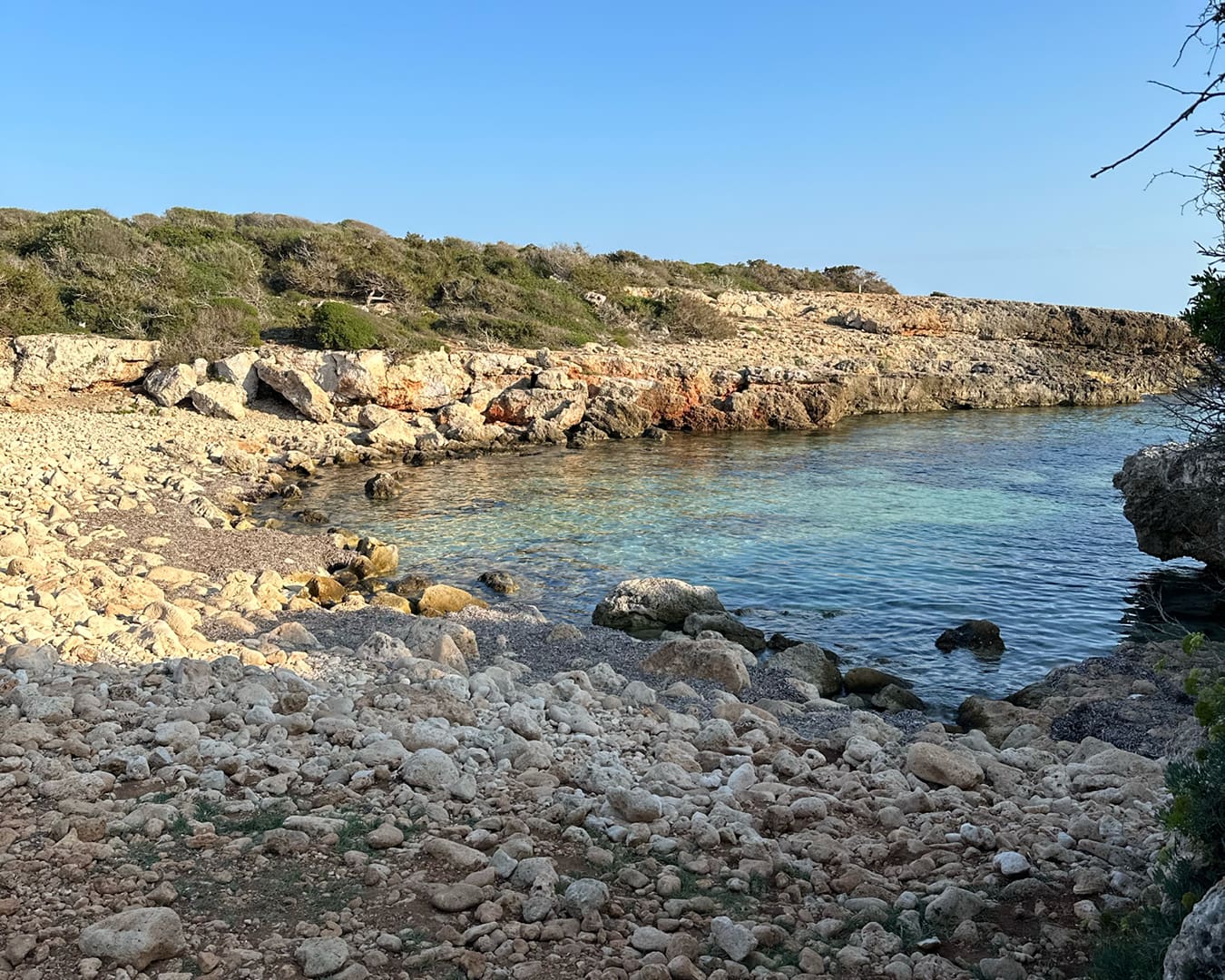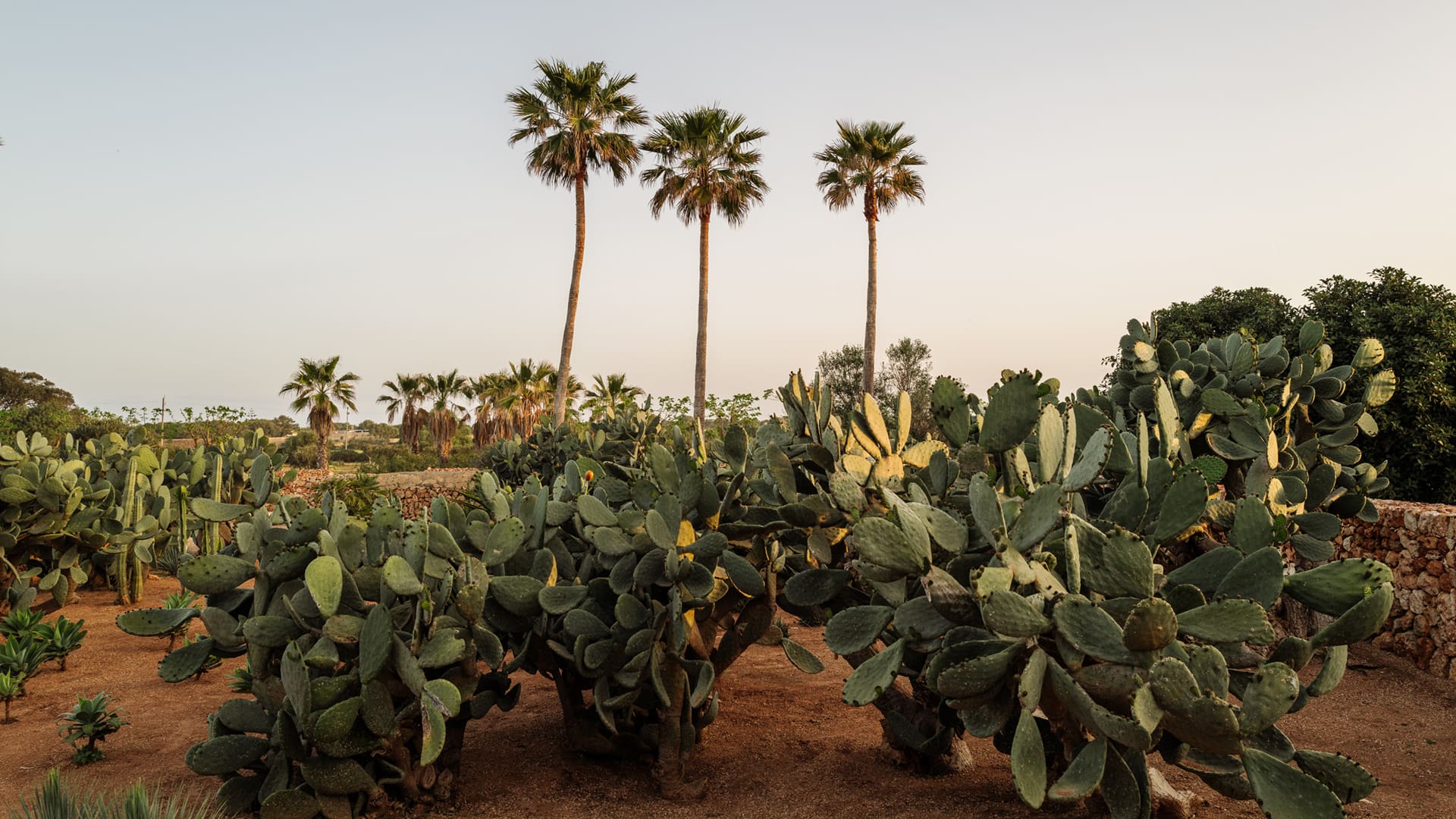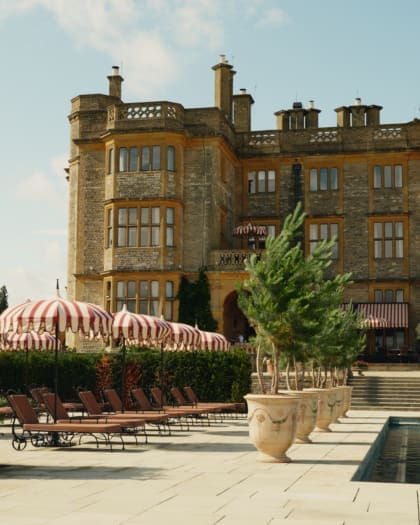
Art, architecture and tradition collide at Son Vell Menorca
With its sensitive restoration bringing a historic former mansion back to life, Son Vell on Menorca is a refined rural retreat that champions slow living
Rugged dry stone walls separate blue sky from red soil as I leave the clear waters of Cala de Son Vell behind me. As the sun dips, I pedal past olive groves, tilled fields and towering barracas – tiered stone structures, like Mayan temples in miniature, that dot the island’s pastures, providing shelter for livestock.
Palms bob their heads as I approach the grand gates of Son Vell, a historic 18th-century finca on Menorca’s southwest coast, set among 200 hectares of agricultural land and whose pale stone form seems to glow in the fading light. At this point there’s little to distinguish the landscapes in front of me from those tended to by farm workers here for centuries.


Son Vell’s second life
However, this stately Palladian pile – dilapidated until its takeover by Vestige Collection a few years ago – has been reborn as a sophisticated agriturismo that has not only restored a grand old mansion but an island-wide sense of pride, championing architectural and agricultural traditions otherwise at risk of decline.
Its grand facade faces directly towards the coast – originally to keep watch for Menorca’s many invaders over the centuries, now illustrating the quickest route to the beautiful beach. Split between the main house and olive-lined grounds, Son Vell now houses 33 refined rooms whose original beams, vaulted ceilings and muted tones combine to create comfortable, charismatic lodgings. Its farm-to-table restaurant Vermell, whose terrace twinkles under starlight as musicians serenade diners, is now housed in what used to be a shelter for the estate’s cows, sheep and mules. The bar occupies the former quesería, where cheeses were pressed, ripened and left to age, while its third floor, once hanging space for sobrasada and chorizo sausage, is now a penthouse suite with commanding views across the 200-acre estate.

After slices of pan de tomate and sobrasada with honey on a sun-dappled terrace, Enrique Motilla Saiz, the project architect, explains the owners’ motivation for saving historic buildings from decline. “There are lots of buildings like this across the island – albeit not quite of this scale or grandeur – that are abandoned and in a state of disrepair, because it takes a lot of money to maintain or restore them,” he says. “By taking on a big piece of land and putting in only a small number of rooms, the owners are searching for a new model of tourism that is low density and works closely with locals.”
On an island where overtourism puts pressure on local communities during peak summer season, Son Vell offers a compelling alternative to the development that has blighted the skylines of many other Mediterranean destinations. Yet, costs aside, it’s a model that’s far from easy to replicate.
The past reborn
“In contrast to Mallorca or Ibiza, which have changed significantly, the heritage committee on Menorca are fighting to retain their traditions and old fincas,” he says. “This is why many new hotels are called agriturismos – you have to keep the agricultural element. During the design of Son Vell, we had to check every little detail with them, with unanimous votes needed from the committee before anything could proceed.”
Originally the home of a noble family, Son Vell and its estate were once managed by a master of the house, who worked alongside a payés, or master of agriculture, who produced food from the land and took a portion of the profits. To ensure the renovation was in keeping with the estate’s past, Motilla Saiz and his team accessed decades-old archival photography of the house and had the good fortune of meeting the grandson of a man who previously worked on the farm in its heyday, who helped shed light on Son Vell’s former life.


Challenges of restoration
A walk through Son Vell is a journey in time, with clues of its past scattered throughout the property. The mansion is hewn from local marés (a variety of sandstone), and adorned with palladian pillars, columned arches and carved eagles emblematic of Sant Joan, the patron saint of nearby Ciutadella. Varying in shade between ochre and white depending on age and exposure to sun, it’s this marés that gives Son Vell its honey and pink-tinged tones. Huge chunks of this stone were cut to different sizes for use throughout the renovation, which involved remodelling the entrance, replacing concrete terracing and restoring and repairing its exterior. “This house has the detail and proportions of a palace, but it’s also so simple – made only from stone, terracotta, wood and lime,” he says. “We wanted the building to speak for itself.”
To transform Son Vell into a luxury hotel while sticking to these traditional elements required hidden, hard-working design. Major challenges included adding insulation between huge slabs of stone, laying original terracotta over underfloor heating and opting to use lime rather than paint, which allows the walls to breathe and naturally regulates moisture and temperature. “On other buildings, you can touch up any damage with paint, but you can’t clean or correct with lime,” says Motilla Saiz. “We didn’t want to use any chemicals, and lime is very typical for Menorca – it’s ecological, hypoallergenic and cleans the air around it.”
Low lighting filtered through canvas creates a charismatic atmosphere across communal areas that include a library and lounge. Original wooden doors were restored to their former glory and supplemented with an eclectic selection of paintings, sculpture and objet d’art from the owner’s collection of historic Spanish pieces, chosen to reflect Menorcan artistic traditions.

Keeping craft alive
As we walk through the estate, beyond nopal cactuses and manicured gardens, gardeners tend to olive trees over 500 years old, and skilled workers repair intricately stacked pared seca (dry stone) walls. “We had to make sure we could find the right craftspeople on Menorca before we could take on this project,” says Motilla Saiz. This included teaming up with the very few artisans on the island still making Menorca’s distinctive wooden gates in the original manner. Known as an arader, these carpenters use wild olive wood, cut and treated for a year and a half, to create highly durable, rugged pieces that have become emblematic of the island.
Another local icon, the indigenous Menorquín horse, is referenced in Son Vell’s sinuous central staircase to the top floor. Motilla Saiz tracked down an octogenarian craftsman, who worked with a colleague for nine months to create the new piece that mirrors the original – an intricate, curving construction in wood, with horse neck detailing on its bannisters linking the history of the house to the present.

Son Vell’s connection to the land and sea continues at dinner. Built around the concept of an alma menorquina (Menorcan soul), Vermell serves up Menorca’s prized red prawns, cochinillo (suckling pig) and a slow-simmered oliaigua soup of estate-grown vegetables. Later, I nurse a negroni, made from local Xoriguer gin, served in rustic stoneware and adorned with rosemary plucked from the grounds, underneath a spectacular blanket of stars.
Yet for all Son Vell’s newfound grandeur, its rugged setting and sense of space remains a drawcard. During an early morning swim in the stone-lined lap pool, cows trot past as the sun appears through the mist. There’s a hatha yoga class silently grouped in a nearby olive grove, and on the horizon a silhouetted trio on horseback trot towards the Cami de Cavalls, the ancient horse trail that encircles the island. Responsible in its approach and refined in its delivery, life at Son Vell goes slow – and welcomingly so.





